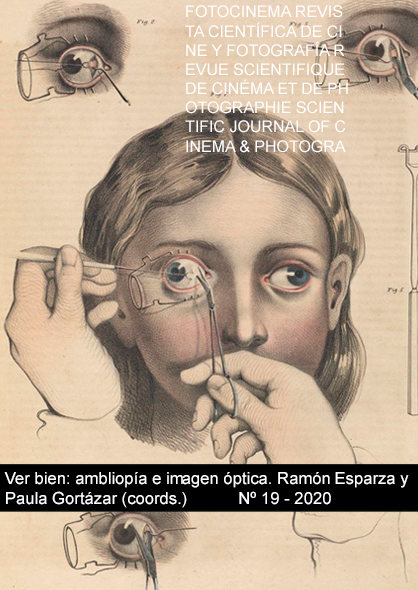Shame (2011) de Steve McQueen. El cine en segundo grado: la hipertextualidad
DOI:
https://doi.org/10.24310/Fotocinema.2019.v2i19.6653Palabras clave:
Transtextualidad, Hipertextualidad, Gérard Genette, Shame, Steve McQueen, American Psycho, Mary Harron, Bret Easton Ellis.Resumen
El objetivo de este trabajo es proponer la existencia de una relación transtextual de hipertextualidad entre Shame (2011), película dirigida por el director británico Steve McQueen, y American Psycho de Mary Harron (2000), adaptación cinematográfica de la novela homónima de Bret Easton Ellis (1991). El fundamento de esta hipótesis descansa tanto en la similitud de los respectivos argumentos y de los recursos cinematográficos (estructurales, transtextuales y retóricos) empleados en las dos películas, como en la intención artística de los cineastas. En un trabajo subsiguiente, se identificará y analizará una serie de citas intertextuales de diferente procedencia también presentes en el filme de McQueen. La superposición de diferentes discursos convierte a Shame en un rico palimpsesto transtextual que proyecta su propio significado a partir de la suma de las significaciones de sus textos subyacentes. Parafraseando la fórmula del semiólogo literario francés Gérard Genette, cuya metodología ha servido de base para el análisis, Shame de Steve McQueen resulta un buen testimonio de “cine en segundo grado”.
Descargas
Métricas
Citas
Algeo, J. (1991). Fifty Years Among the New Words: A Dictionary of Neologisms. Cambridge: Cambridge University Press.
Allen, G. (2000). Intertextuality. London-New York: Routledge.
Baelo Allué, S. (2002). The aesthetics of serial killing: Working against ethics in The Silence of the Lambs (1988) and American Psycho (1991), Atlantis. Revista de la Asociación Española de Estudios Anglo-Norteamericanos, 24.2, 7-24.
Díaz Gito, M.A. (2019). El Infierno, según Steve McQueen. Shame (2011) y las Hijas de Dánao, International Journal of the Classical Tradition, 26, en prensa.
Featherstone, M. (2016). Carnotopia: The Culture of Sadism in Nymphomaniac, Shame and Thanatomorphose. En J. Gwynne (Ed.), Transgression in Anglo-American Cinema: Gender, Sex and the Deviant Body (pp. 25-42), London-New York: Wallflower Press.
Genette, G. (1989). Palimpsestos. La literatura en segundo grado. Madrid: Taurus (=1982).
González Etxeberria, J. (2017). Epopeyas postmodernas y topografías infernales sin salida. En J. M. Losada & A. Lipscomb (Eds.), Myth and Emotions (pp. 279-290). Cambridge: Cambridge Scholars Publishing.
Holtsmark, E.B. (2001). The Katabasis Theme in Modern Cinema. En M.M. Winkler (Ed.), Classical Myth and Culture in the Cinema (pp. 23-50). Oxford: Oxford University Press [=Classics and Cinema (1991)].
Holtsmark, E.B. (1997). Films and Ring Composition. KLEOS. Estemporaneo di Studi e Testi sulla Fortuna dell’Antico, 2, 271-274.
Kauffman, L. (2000-2001). American Psycho, Film Quarterly, 54.2, 41-45.
Kooijman, J. & T. Laine (2003). American Psycho: A double portrait of serial yuppie Patrick Bateman, Post Script, 22.3, 46-57.
Kristeva, J. (1986). Word, Dialogue and Novel. En T. Moi (Ed.), The Kristeva Reader (pp. 34-61). New York: Columbia University Press.
Lee, C. (2013). Shopping and Slaying, Fucking and Flaying: Serial Consumption in American Psycho. En A. MacDonald (Ed.), Murders and Acquisitions: Representations of the Serial Killer in Popular Culture (pp. 105-122). New York: Bloomsbury.
Marinkovich, J. (1998-1999). El análisis del discurso y la intertextualidad, Boletín de Filología de la Universidad de Chile, 37, 729-742.
Pardo García, P.J. (2010). Teoría y práctica de la reescritura filmoliteraria (A propósito de las reescrituras de The Turn of the Screw). En J.A. Pérez Bowie (Ed). Reescrituras fílmicas. Nuevos territorios de la adaptación (pp. 45-102). Salamanca: Universidad.
Pérez Bowie, J.A. (ed.) (2010). Reescrituras fílmicas. Nuevos territorios de la adaptación. Salamanca: Universidad.
Pérez Bowie, J.A. (2008). Cine e Intertextualidad. En Idem, Leer el cine. La teoría literaria en la teoría cinematográfica (pp. 151-167). Salamanca: Universidad.
Robinson, D. (2006). The Unattainable Narrative: Identity, Consumerism and the Slasher Film in Mary Harron’s American Psycho, CineAction, 68, 26-35.
Sánchez-Escalonilla, A. (2005). The Hero as a Visitor in Hell. The Descent into Hell in Film Structure, Journal of Popular Film and Television 32.4, 149-156.
Stam, R. (2005). Introduction: The Theory and Practice of Adaptation. En R. Stam & A. Raengo (Edd.), Literature and Film. A Guide to the Theory and Practice of Film Adaptation (pp. 1-52, esp. 26-31). Malden-Oxford: Blackwell Publishing.
Publicado
Cómo citar
Número
Sección
Licencia
Todos los contenidos publicados en Fotocinema. Revista científica de cine y fotografía están sujetos a la licencia Creative Commons Reconocimento-NoComercia-Compartirigual 4.0 cuyo texto completo puede consultar en <http://creativecommons.org/licenses/by-nc-sa/4.0>
Se pueden copiar, usar, difundir, transmitir y exponer públicamente, siempre que:
- Se cite la autoría y la fuente original de su publicación (revista, editorial y URL de la obra).
- No se usen para fines comerciales.
- Se mencione la existencia y especificaciones de esta licencia de uso.
Los derechos de autor son de dos clases: morales y patrimoniales. Los derechos morales son prerrogativas perpetuas, irrenunciables, intransferibles, inalienables, inembargables e imprescriptibles. De acuerdo con la legislación de derechos de autor, Fotocinema. Revista científica de cine y fotografía reconoce y respeta el derecho moral de los autores/as, así como la titularidad del derecho patrimonial, el cual será cedido a la Universidad de Málaga para su difusión en acceso abierto. Los derechos patrimoniales, se refieren a los beneficios que se obtienen por el uso o divulgación de las obras. Fotocinema. Revista científica de cine y fotografía se publica en open access y queda autorizada en exclusiva para realizar u autorizar por cualquier medio el uso, distribución, divulgación, reproducción, adaptación, traducción o transformación de la obra.
Es responsabilidad de los autores/as obtener los permisos necesarios de las imágenes que están sujetas a derechos de autor.













13.png)




